Small courtyard gardens are often dismissed as too limited to do much with.
But with the right approach, even the tightest courtyard can be turned into a relaxing, stylish, and useful outdoor area.
Whether you're working with a narrow concrete patch or a boxed-in yard between walls, the key is using space wisely without overcrowding it.
From vertical planting to clever furniture, this article covers 10 practical ideas that make the most of every inch without sacrificing comfort or charm.
What to Consider in a Small Courtyard Garden
Designing a small courtyard garden isn't just about picking pretty plants or stylish furniture.
It's about understanding the space you have and how you want to use it. Before applying any ideas, take time to assess a few key things:
- Natural Light: Know which parts of your courtyard get full sun, partial shade, or deep shade. This affects your plant choices and seating placement.
- Access and Flow: Consider how people will move through the space. Avoid blocking paths with large planters or furniture that sticks out.
- Privacy Needs: Small courtyards are often close to neighbors. Think about screening or climbing plants that can provide some cover without closing the space in.
- Wind and Drainage: These tight spaces can have tricky microclimates. If the area is exposed or poorly drained, choose hardier materials and low-maintenance plants.
- Purpose of the Space: Decide if you want your courtyard to be a quiet retreat, a space for dining, or an area for container gardening. This will guide every design choice you make.
Taking these factors into account early makes each design decision more effective and helps avoid wasted effort or money.
With a clear plan in mind, the 10 ideas below will be easier to apply and customize to your exact space.
10 Space-Smart and Stylish Ideas for Small Courtyard Gardens
Courtyards may be tight on space, but with the right design choices, they can still be full of charm, function, and greenery.
Below are ten well-thought-out ideas that help you get the most out of a small courtyard without overwhelming it.
1. Reflect Light and Expand the View with Mirrors and Pale Walls

In small courtyard gardens, every surface has a job. Walls, in particular, can either close in the space or help open it up.
Painting boundary walls in a bright white or other light-reflective tone can instantly make the area feel less confined.
When those pale colors match or blend with the surroundings beyond the courtyard, the boundaries seem to disappear altogether.
Another way to create the illusion of more space is to install an oversized outdoor mirror. Choosing one styled like a window adds depth while keeping the look balanced.
Position it to reflect plants or sky rather than solid walls to avoid a boxed-in effect. For longevity, always use mirrors rated for outdoor use and stick with exterior masonry paint when painting walls.
Used together, these tricks allow light to bounce around and give the courtyard an open, airy atmosphere without altering the physical size at all.
2. Grow Upward with Climbers and Wall Supports

When floor space is limited, the only way to go is up. Vertical gardening is one of the most effective ways to introduce greenery into a courtyard without taking up much room.
Climbers like jasmine, wisteria, and climbing roses are ideal because they offer strong coverage, fragrance, and seasonal interest.
They can be trained along a wall, trellis, or even simple bamboo supports.
To get the best results, install fixed supports that encourage plants to spread out evenly across a vertical surface.
Choose structures that match the style of your space – metal trellises suit modern courtyards, while natural wood blends better in rustic or informal spaces.
This approach allows you to bring in dense plant life while keeping the ground open for seating, pots, or pathways.
3. Extend Use into the Evening with Outdoor Lighting
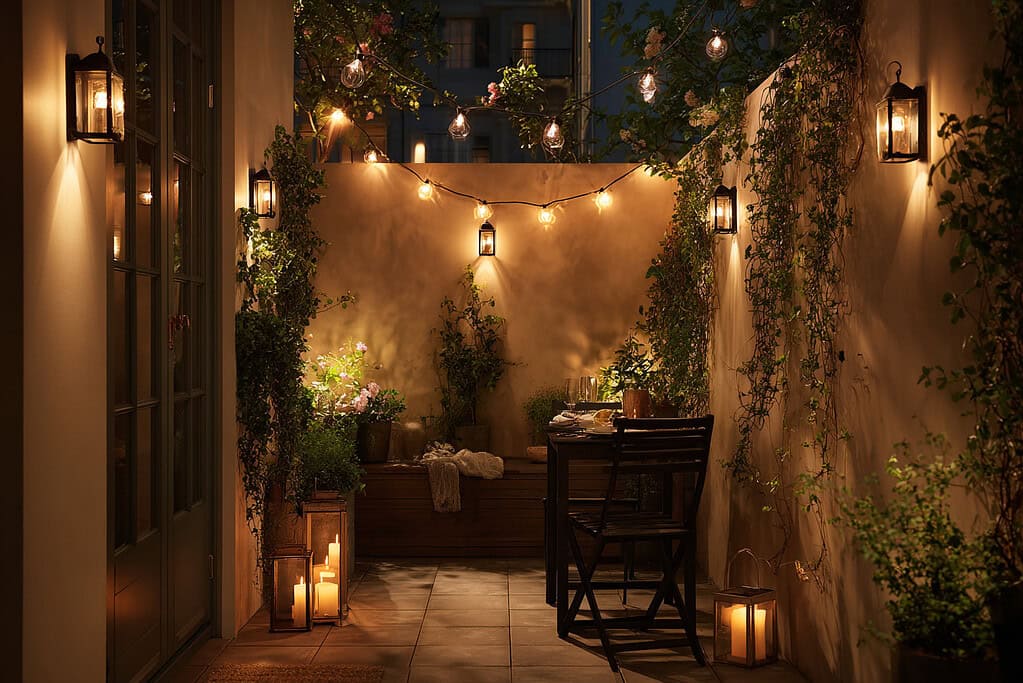
Outdoor lighting is a practical way to make a small courtyard usable after dark. Well-placed lighting helps define space, adds atmosphere, and brings focus to key features.
Wall-mounted lanterns or hook-hung fixtures work well in tight areas, providing ambient light without cluttering the floor.
String lights are another smart option for courtyards. When hung above eye level, they visually lift the ceiling of the space and soften its outlines.
For a more flexible setup, decorative candle holders or oil lamps can be added during evening use without committing to a full wired system.
Just be sure to use weatherproof options if they’re staying out year-round.
Lighting lets you enjoy the courtyard longer and creates a warm, inviting mood even when the sun is gone.
4. Keep Things Coherent with a Simple, Uncluttered Layout

In a small courtyard, too many materials or competing design elements can quickly lead to visual clutter. The key is to streamline – not strip down – your layout.
Stick to a narrow palette of hard landscaping materials, ideally no more than three. For example, you might combine brick pavers, gravel, and wood in a way that still feels calm and connected.
Plant choices should follow the same rule. Choose a mix that works well together in terms of height, texture, and color. Avoid cramming too many species into one bed or container.
When every feature has breathing room, the whole space feels more open, functional, and easier to maintain.
If you need help mapping out the bigger picture, here’s a guide on how to plan your backyard landscaping.
5. Choose Furniture That Saves Space Without Sacrificing Comfort
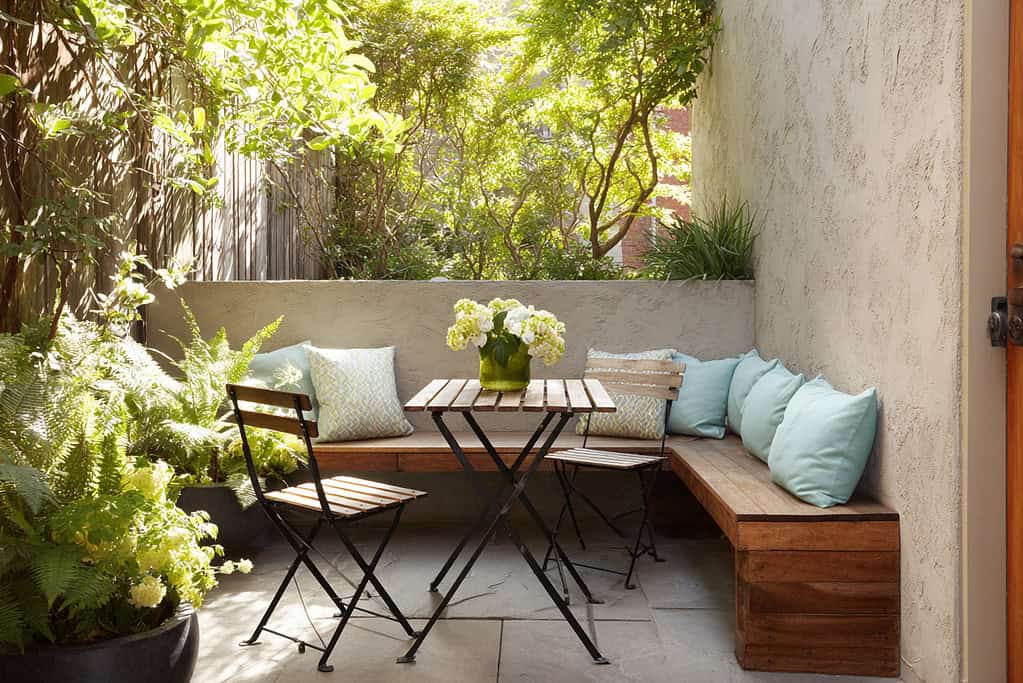
Every item in a courtyard needs to earn its spot, especially furniture. Rather than bulky seating or large tables, look for compact options that can tuck away when not in use.
Bistro tables with foldable chairs, slimline benches, or narrow dining sets are all well-suited to tight layouts.
For courtyards that are especially narrow or enclosed, consider benches that run along a wall – these provide seating without obstructing footpaths.
A traditional wooden bench paired with outdoor cushions can also double as a quiet reading spot or lounging area.
When possible, go for furniture that serves multiple uses, like tables with built-in storage or benches that slide under tables when not needed.
Comfort doesn’t have to be sacrificed – it just needs to be well planned.
6. Create Depth with Diagonal Layouts and Receding Colors
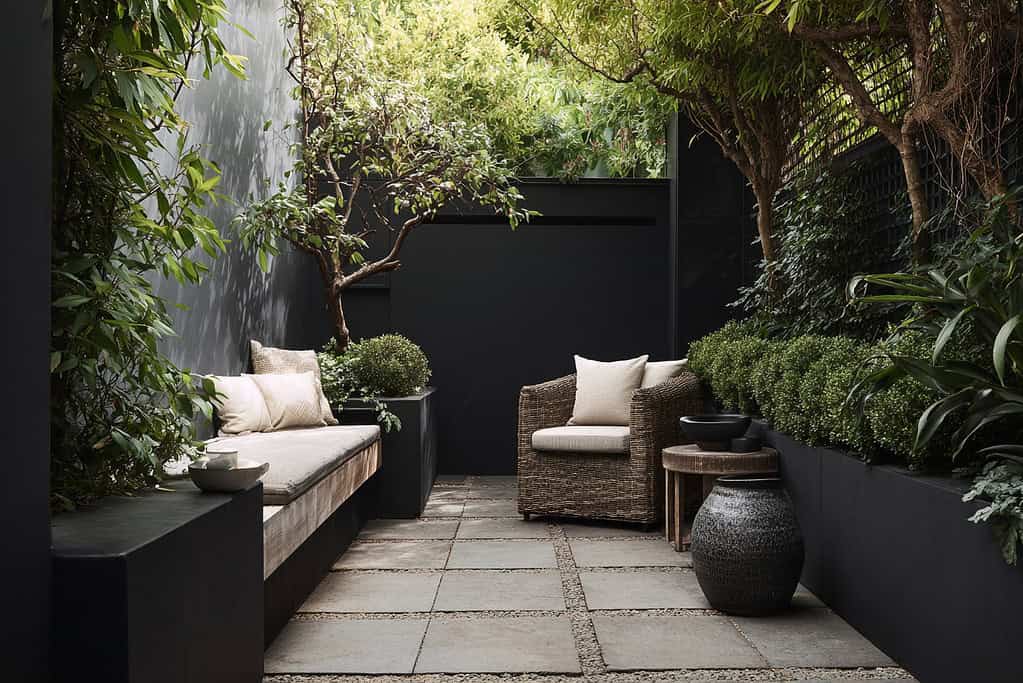
How a courtyard is laid out has a big effect on how spacious it feels. One simple visual trick is to use a diagonal layout for paving, decking, or major design lines.
When angles are introduced instead of straight edges, it breaks up the squareness of a tight courtyard and draws the eye outward, making the area seem wider or deeper than it actually is.
Color also plays a major role. Painting boundary fences or walls in dark tones, like black or deep charcoal, helps them recede visually.
This makes the edges feel less harsh and puts the focus on plants or furniture instead. It’s a subtle change, but one that can shift the mood of the entire space from boxed-in to open.
7. Use Planters and Pots to Soften Hard Edges
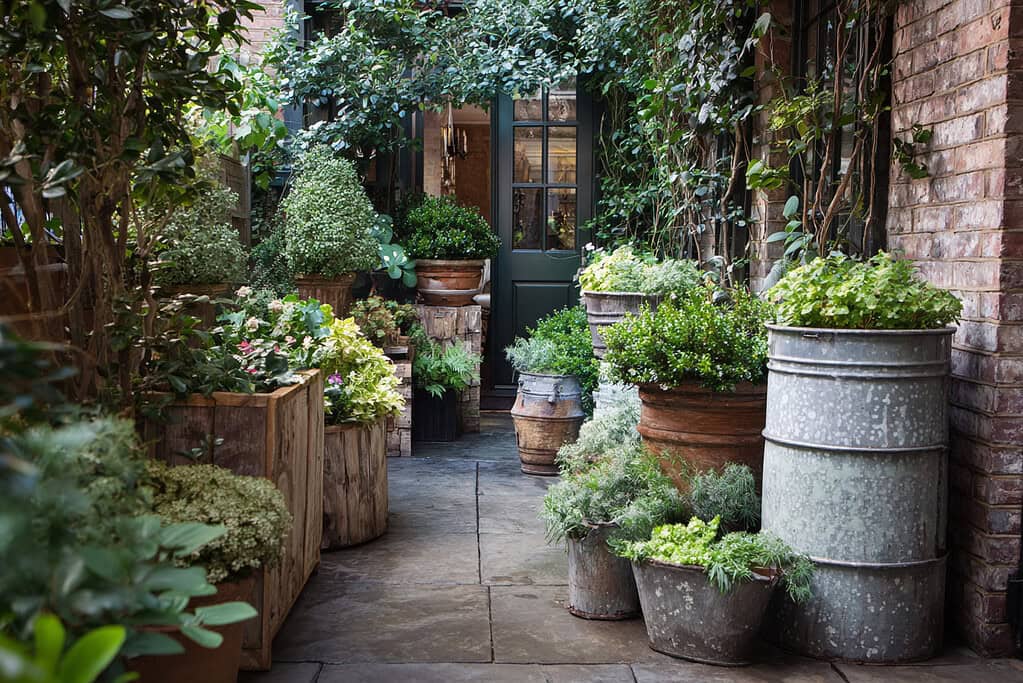
Courtyards often have hard surfaces – brick, concrete, stone – that can make them feel rigid or cold.
Introducing planters and pots is a flexible way to soften those edges and bring in greenery. Containers are easy to move, rework, and scale to fit any size of space.
To add visual interest, vary the height and width of your containers. Combine terracotta pots, metal tubs, and wooden crates to create a layered look in corners or along walls.
This also helps frame the space and guide movement through it. In small areas, grouping pots together is usually more effective than spreading them out.
Pots are also great for growing herbs, small vegetables like strawberries, or scented plants that bring function and enjoyment without requiring a garden bed. In a courtyard, that flexibility matters.
For inspiration, check out these best DIY planters that can elevate your courtyard instantly.
8. Build Year-Round Interest with Evergreen Structure

In a small courtyard, it’s important that the space looks good in every season – especially in winter when most plants die back.
That’s where evergreen plants come in. They hold their form and color all year and help give the space structure when little else is growing.
Low-maintenance evergreens like Ilex domes, boxwood, or dwarf mountain pine offer compact shapes that fit easily into containers or border spaces.
For shadier spots, Sarcococca (sweet box) is a strong choice – it's compact, evergreen, and produces fragrant blooms in late winter when little else flowers.
Evergreens don’t need to dominate the space. Even a few well-placed plants can anchor the layout and give it a finished look throughout the year.
9. Carve Out a Defined Seating or Nook Area

Even the smallest courtyard can benefit from a clear seating zone. Instead of scattering furniture around, define one corner or edge of the courtyard as a dedicated sitting area.
A built-in bench, an arbour seat, or even a tucked-away chair with cushions can make a big difference in how the space is used.
Surrounding this nook with plants – in pots, raised beds, or climbing on a wall – helps soften the space and add privacy. It can become a cozy place for a morning coffee or quiet break, separate from the rest of the garden's activity.
A defined nook turns a basic courtyard into a functional outdoor room, giving it purpose and a natural gathering point.
Want more inspiration? Try these simple garden nook ideas.
10. Add Functionality with Multi-Use Garden Features
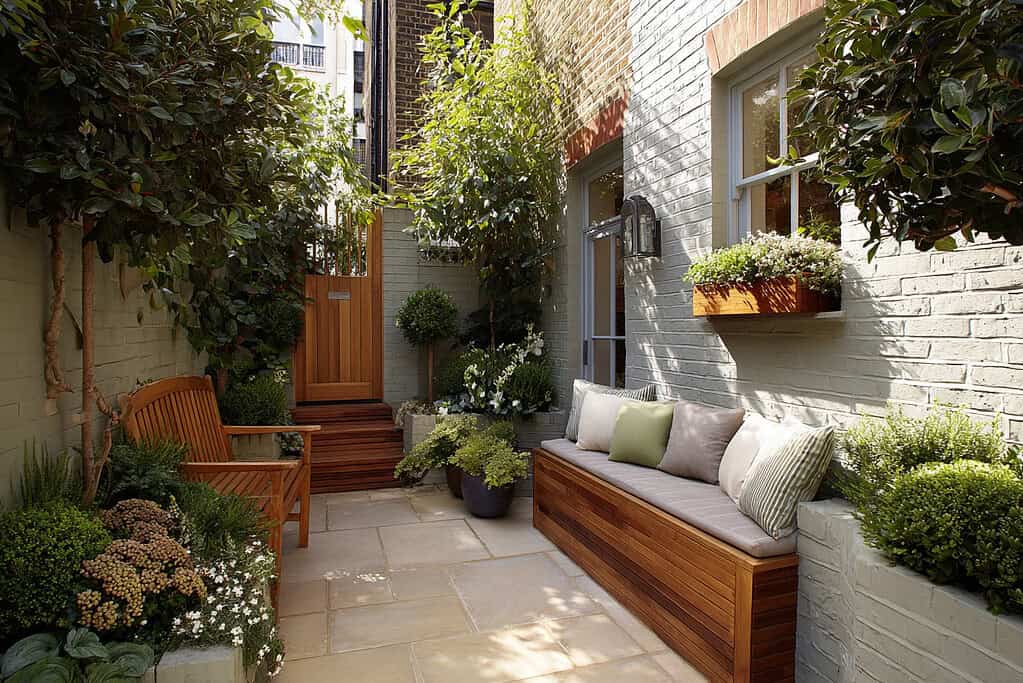
In small courtyards, pieces that serve more than one role are a smart use of space.
Instead of filling the area with separate items for storage, seating, or planting, look for features that combine functions. A bench with hidden storage beneath it can keep tools or cushions out of sight.
A raised planter with a flat edge can double as casual seating. Even a narrow wall-mounted table can fold down when needed and disappear when it’s not.
This approach keeps the courtyard neat while increasing how much you can actually do with it.
These kinds of features are especially helpful in rental spaces or areas where permanent changes aren’t allowed.
By thinking in terms of flexibility and purpose, even a compact courtyard becomes easier to use and maintain.
Start Small, Plan Smart, and Make It Yours
A well-planned courtyard can feel open, peaceful, and useful all year long, no matter how limited the footprint.
Start by observing how your courtyard behaves throughout the day – where the light hits, how you move through it, and what you want to use it for.
Then apply the ideas that align with your needs.
Whether it’s adding climbers, choosing better furniture, or just painting the walls, each small change builds toward a space that’s more enjoyable and easier to live with.
Have your own tip, question, or experience to share? Comment down below – we’d love to hear how you're transforming your courtyard.
FAQs
1. What are the best plants for courtyards with very little sunlight?
Courtyards that receive minimal light can still support a variety of shade-tolerant plants. Good options include ferns, hostas, heucheras, and Sarcococca (sweet box). For evergreen impact, try fatsia japonica or ivy. Make sure the soil drains well, as shaded spots often stay damp.
2. How do I protect my courtyard furniture from weather without adding bulk?
Opt for weather-resistant materials like powder-coated metal, treated wood, or synthetic wicker. When not in use, use fitted waterproof covers or choose foldable furniture that can be stored in a shed or against a wall with minimal space. Furniture with built-in storage can also hold its own cover.
3. What can I do if my courtyard is very windy?
Wind-prone courtyards benefit from solid or semi-solid windbreaks. Trellises with climbing plants, tall planters, or slatted screens can break the wind without fully closing off the space. Choose sturdy furniture and anchor lightweight items when possible.
4. Can I add water features in a small courtyard?
Yes – compact water features like wall-mounted fountains, basin-style bubbling pots, or recirculating mini waterfalls work well. They add sound and movement without using much space. Just make sure they’re proportionate to the space and positioned where splashing won’t be an issue.
5. How can I add privacy without making the courtyard feel smaller?
Use vertical elements like trellises with climbing plants, tall planters, or decorative screens. These provide privacy without blocking air or light. Stick to lighter colors or slatted designs to keep the space from feeling boxed in.
